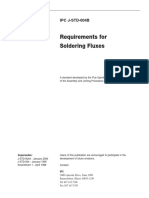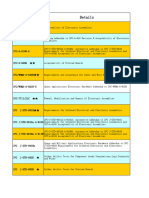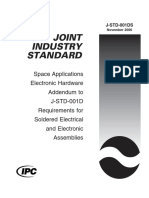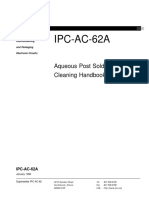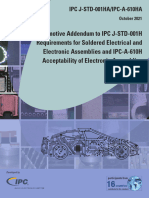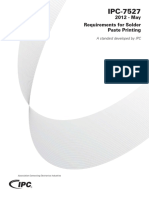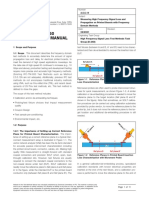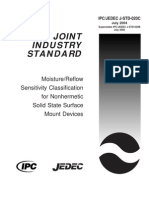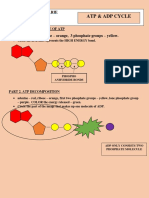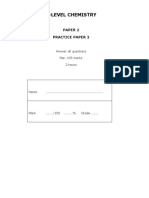J STD 006B
J STD 006B
Uploaded by
Alejandra GCopyright:
Available Formats
J STD 006B
J STD 006B
Uploaded by
Alejandra GOriginal Title
Copyright
Available Formats
Share this document
Did you find this document useful?
Is this content inappropriate?
Copyright:
Available Formats
J STD 006B
J STD 006B
Uploaded by
Alejandra GCopyright:
Available Formats
IPC J-STD-006B with Amendments 1 & 2
Requirements for Electronic
Grade Solder Alloys and
Fluxed and Non-Fluxed
Solid Solders for Electronic
Soldering Applications
Developed by the Solder Alloy Task Group (5-24c) of the Assembly
and Joining Processes Committee (5-20) of IPC
Supersedes:
J-STD-006B w/Amendment 1 October 2008
J-STD-006B - January 2006
Amendment 1 - June 2008
J-STD-006A - May 2001
J-STD-006 - January 1995
Amendment 1 - July 1996
Users of this standard are encouraged to participate in the
development of future revisions.
Contact:
IPC
3000 Lakeside Drive, Suite 309S
Bannockburn, IL 60015-1249
Phone (847) 615-7100
Fax (847) 615-7105
October 2009
IPC J-STD-006B with Amendments 1 & 2
Table of Contents
1
SCOPE AND CLASSIFICATION .............................. 1
1.1
1.2
Scope ................................................................... 1
Classification ....................................................... 1
1.2.1
1.2.2
1.2.3
1.2.4
1.2.5
1.2.6
Alloy Composition .............................................
Alloy Impurity Level ..........................................
Solder Form ........................................................
Dimensional Characteristics ...............................
Flux Percentage and Metal Content ..................
Flux Classification ..............................................
1
1
1
1
1
1
APPLICABLE DOCUMENTS .................................... 1
2.1
2.2
Joint Industry Standards ..................................... 1
International Standards Organization (ISO) ...... 2
2.3
2.4
IPC ...................................................................... 2
American Society for Testing and Materials
(ASTM) ............................................................... 2
2.5
2.6
2.6.1*
Order of Precedence ........................................... 2
Terms and Definitions ........................................ 2
Acceptance Tests ................................................ 2
2.6.2
2.6.3
2.6.4
2.6.5*
2.6.6
Base Metal ..........................................................
Corrosion ............................................................
Density ................................................................
Dewetting ............................................................
Eutectic ...............................................................
2.6.7*
2.6.8
Flux ..................................................................... 2
Flux Characterization ......................................... 2
2.6.9
2.6.10
2.6.11
2.6.12
2.6.13
2.6.14*
Flux Residue .......................................................
Liquidus ..............................................................
Nonwetting ..........................................................
Solder ..................................................................
Solidus ................................................................
Wetting, Solder
2
2
2
2
2
2
2
2
3
3
3.4.6
Special Form Solder ........................................... 4
3.5
3.5.1
3.5.1.1
3.5.2
3.6
3.6.1
3.6.2
Fluxed Solder Characteristics ............................
Flux Cored Solder ..............................................
Spitting ................................................................
Flux Coated Solder .............................................
Flux Characteristics ............................................
Flux Percentage ..................................................
Flux Classification ..............................................
4
4
4
4
4
4
4
3.6.3
3.6.4
3.7
3.8
Solder Pool .........................................................
Flux Residue Dryness ........................................
Labeling for Product Identification ....................
Workmanship ......................................................
4
5
5
5
QUALITY ASSURANCE PROVISIONS .................... 5
4.1
Responsibility for Inspection ............................. 5
4.2
Responsibility for Compliance ........................... 5
4.3
Quality Assurance Program ................................ 5
4.4
Categories of Inspections ................................... 5
4.4.1
Materials Inspection ........................................... 5
4.4.2
Qualification Inspections .................................... 5
4.4.3
Quality Conformance Inspections ...................... 5
4.5
Test Equipment and Inspection Facilities .......... 6
4.6
Inspection Conditions ......................................... 6
4.7
Inspection Routine .............................................. 6
4.8
Inspection Sampling ........................................... 6
4.9
Preparation of Solder Alloy for Test ................. 6
4.9.1
Flux Cored Solder .............................................. 6
4.9.2
Wire Solder Up to Approximately 6 mm
Diameter .............................................................. 6
4.9.3
Ribbon Solder and Other Wire Solder .............. 6
4.10
Failure ................................................................. 7
4.11
Inspection Reporting .......................................... 7
REQUIREMENTS ...................................................... 3
5
PREPARATION FOR DELIVERY .............................. 7
3.1
3.2
3.3
Materials ............................................................. 3
Alloy Composition ............................................. 3
Alloy Impurities .................................................. 3
3.3.1
Variation D Alloys .............................................. 3
6.1
Selection .............................................................. 7
3.4
Solder Forms and Dimensional
Characteristics ................................................... 4
6.1.1
Alloys .................................................................. 7
3.4.1
Bar Solder ........................................................... 4
3.4.2
Wire Solder ......................................................... 4
6.1.1.2 Bismuth-Containing and BismuthBased Alloys ....................................................... 7
3.4.3
Ribbon Solder ..................................................... 4
6.1.1.3 Cadmium-Containing Alloys .............................. 7
3.4.4
Solder Powder
................................................. 4
6.1.1.4 Copper-Containing Alloys .................................. 7
3.4.5
Spheres ................................................................ 4
6.1.1.5 Gold Alloys ......................................................... 7
5.1
6
Preservation, Packing, and Packaging ............... 7
NOTES ....................................................................... 7
6.1.1.1 Antimony-Containing Alloys ............................. 7
IPC J-STD-006B with Amendments 1 & 2
6.1.1.6 Indium-Containing and IndiumBased Alloys .......................................................
6.1.1.7 Lead-Free Alloys ................................................
6.1.1.8 Silver-Containing Alloys ....................................
6.1.1.9 Tin-Silver-Copper Alloys with or
without Antimony ...............................................
6.2
6.2.1
6.2.2
6.2.3
6.2.4
6.3
6.4
6.5
Standard Solder Product Packages ....................
Wire and Ribbon Solders ...................................
Bar Solders .........................................................
Solder Powder ....................................................
Solder Spheres ....................................................
Standard Description of Solid
Solder Products ...................................................
Qualitative Test for the Presence of Lead .........
Labeling for Lead-Free and Leaded
Marking, Symbols and Labels ...........................
October 2009
7
7
8
8
8
8
8
8
8
8
Appendix B
Examples of Inspection Report
Format ................................................... 18
ii
Appendix B-4
Inspection Report for Solder
Powder ............................................... 21
Figures
Figure 6-1
Test Report for Solder Alloy
Composition and Impurity
Level .................................................. 18
Inspection Report for Fluxed
Wire/Ribbon Solder .......................... 19
Recommended Lead Free Marking Symbol .... 8
Tables
Table 4-1
Requirements and Inspection Routine ................ 6
Table A-1
Composition, and Temperature
Characteristics of Lead-free
Solder Alloys ..................................................... 10
Table A-2
Composition and Temperature
Characteristics of Common
Tin-Lead Alloys .................................................. 12
Table A-3
Composition and Temperature
Characteristics for Specialty (nonTin/Lead) Alloys ................................................. 14
Table A-4
Cross-Reference from Solidus and
Liquidus Temperatures to Alloy
Names by Temperature ..................................... 15
Table A-5
Cross-Reference from ISO 9453
Alloy Numbers and Designations
to J-STD-006 Alloy Names ............................... 17
Solder Alloys ........................................ 10
Appendix B-2
Inspection Report for NonFluxed Solder .................................... 20
Appendix A
Appendix B-1
Appendix B-3
October 2009
IPC J-STD-006B with Amendments 1 & 2
Requirements for Electronic Grade Solder Alloys
and Fluxed and Non-Fluxed Solid Solders
for Electronic Soldering Applications
1 SCOPE AND CLASSIFICATION
1.1 Scope This standard prescribes the nomenclature,
requirements and test methods for electronic grade solder
alloys; for fluxed and non-fluxed bar, ribbon, and powder
solders, for electronic soldering applications; and for special electronic grade solders. This is a quality control standard and is not intended to relate directly to the materials
performance in the manufacturing process. Solders for
applications other than electronics should be procured
using ASTM B-32.
This standard is one of a set of three joint industry standards that prescribe the requirements and test methods for
soldering materials for use in the electronics industry. The
other two joint industry standards are:
IPC/EIA J-STD-004
Requirements for Soldering Fluxes
IPC/EIA J-STD-005
Requirements for Soldering Pastes
Additionally, marking requirements for lead-free materials
and assemblies is addressed in this document by direct
application of text from IPC/JEDEC J-STD-609, LeadFree and Leaded Marking, Symbols and Labels (see 6.5).
Soldering alloys covered by this standard shall be classified by alloy composition and impurity
level, solder form and dimensional characteristics peculiar
to the solder form, flux percentage and flux classification,
if applicable. These classifications shall be used as part of
the standard description of solder products (see 6.3).
1.2 Classification
1.2.1 Alloy Composition The solder alloys covered by
this standard include, but are not limited to, the alloys
listed in Appendix A, including pure tin and pure indium.
Each alloy is identified by an alloy name, which is composed of a series of alphanumeric characters that identify
the component elements in the alloy by chemical symbol
and nominal percentage by mass.
1.2.2 Alloy Impurity Level The allowable impurity level
of the solder alloys covered by this standard is identified in
3.3. See 3.3.1 for the description of Variation D alloys. The
alloy variation letter D is added to the end of an alloy name
and becomes part of the alloys name.
1.2.3 Solder Form The forms of solder materials covered by this set of standards include paste (cream), bar,
powder, ribbon, wire and special electronic grade solders
which do not fully comply with the requirements of standard solder alloys and forms listed herein. Some examples
of special form solders are anodes, ingots, preforms, bars
with hook and eye ends, and multiple-alloy solder powders.
A single-letter identifying symbol as defined below may be
used.
P Paste (Cream)
B Bar
D Powder
R Ribbon W Wire
S Special
H Sphere
1.2.4 Dimensional Characteristics Standard bar solders
are further classified by unit mass. Wire solders are further
classified by wire size (outside diameter) and unit mass.
Ribbon solders are further classified by thickness, width
and unit mass. Powder solders are further classified by
powder particle size distribution and unit mass (see 3.4.1 to
3.4.5).
1.2.5 Flux Percentage and Metal Content The nominal
percentage of flux by mass in solid-form solder products
shall be specified. For solder paste products, metal content
shall be specified instead. Metal content refers to the
percentage of metal in solder paste by mass (see 3.4.1 to
3.4.5).
1.2.6 Flux Classification The material of composition,
activity level and halide content of fluxes covered by this
set of standards shall be specified according to IPC/EIA
J-STD-004.
2 APPLICABLE DOCUMENTS
The following documents form a part of this standard to
the extent specified herein. Unless a specific issue is cited
herein or in the contract or purchase order, the issue in
effect on the date of invitation for bids or request for proposal shall apply.
2.1 Joint Industry Standards1
IPC/EIA J-STD-004
Requirements for Soldering Fluxes
IPC/EIA J-STD-005
Requirements for Soldering Pastes
1. www.ipc.org
You might also like
- IPC-CH-65 Cleaning GuidelinesDocument56 pagesIPC-CH-65 Cleaning GuidelinesAlecsandruNeacsu100% (1)
- J STD 001Document1 pageJ STD 001Azhar Qureshi0% (4)
- IPC-6012F 2023 En, Qualification and Performance Specification For Rigid Printed BoardsDocument16 pagesIPC-6012F 2023 En, Qualification and Performance Specification For Rigid Printed Boardscdming50% (2)
- Ipc J-Std-030a-2014Document48 pagesIpc J-Std-030a-2014vahid hajihasaniNo ratings yet
- J STD 003 PDFDocument28 pagesJ STD 003 PDFChung Le0% (1)
- Ipc 7527Document3 pagesIpc 7527ram dhuke50% (2)
- Ipc HDBK 830Document6 pagesIpc HDBK 830julissa.nu.soNo ratings yet
- Remington The Science and Practice of Pharmacy Free PDF DownloadDocument12 pagesRemington The Science and Practice of Pharmacy Free PDF DownloadUmair MazharNo ratings yet
- Requirements For Soldered Electrical and Electronic AssembliesDocument6 pagesRequirements For Soldered Electrical and Electronic AssembliesVenkateswaran venkateswaran40% (5)
- IPC J STD 006C 2013, RequirementsDocument36 pagesIPC J STD 006C 2013, Requirementsvahid hajihasani100% (1)
- IPC-J-STD-004B Requirements For Soldering FluxesDocument4 pagesIPC-J-STD-004B Requirements For Soldering FluxesAlejandra G0% (2)
- IPC J-STD-004C en 2022 Requirements For Soldering FluxesDocument16 pagesIPC J-STD-004C en 2022 Requirements For Soldering Fluxescdming25% (4)
- IPC Standard ListDocument40 pagesIPC Standard Listcdming0% (1)
- Joint Industry Standard: Solderability Tests For Printed BoardsDocument16 pagesJoint Industry Standard: Solderability Tests For Printed BoardsKishor JadhavNo ratings yet
- J-STD-001E Table of ContentsDocument6 pagesJ-STD-001E Table of ContentskhanjrkhanNo ratings yet
- Ipc CH 65B (L)Document216 pagesIpc CH 65B (L)Ramesh S100% (1)
- Ipc 6012ammend1Document5 pagesIpc 6012ammend1Eletrônica Industrial0% (1)
- Ipc 2222a PDFDocument4 pagesIpc 2222a PDFAmanda Vaughn20% (5)
- Ansi Esd S1.1 2021Document2 pagesAnsi Esd S1.1 2021chia-Wei Liao67% (3)
- J STD 00XDocument31 pagesJ STD 00XXucoSongNo ratings yet
- JEDEC Solderability 22B102EDocument26 pagesJEDEC Solderability 22B102EAlex Garcia100% (1)
- IPC D - 317a High Speed Packaging PDFDocument83 pagesIPC D - 317a High Speed Packaging PDFChung LeNo ratings yet
- IPC-TM-650 Test Methods Manual: Association Connecting Electronics IndustriesDocument4 pagesIPC-TM-650 Test Methods Manual: Association Connecting Electronics IndustriesAngus CHUNo ratings yet
- IPC Training and Reference Guide - DRM-18HDocument19 pagesIPC Training and Reference Guide - DRM-18HLane MedaNo ratings yet
- Ipc 7093Document7 pagesIpc 7093Lina Gan0% (1)
- J STD 001DS AddendumDocument22 pagesJ STD 001DS AddendumDott. Giuseppe MaruzzellaNo ratings yet
- WS 1.3 and 1.4 Brownian Motion and DiffusionDocument6 pagesWS 1.3 and 1.4 Brownian Motion and DiffusionHema Lata100% (2)
- Vul Can VGPCRT Chloride Guard TechnologyDocument30 pagesVul Can VGPCRT Chloride Guard Technologybakhtyar21No ratings yet
- IPC-AC-62 Aqueous CleaningDocument87 pagesIPC-AC-62 Aqueous CleaningAlecsandruNeacsuNo ratings yet
- 001 B Operator TrainingDocument129 pages001 B Operator TrainingWandyy GonçalvesNo ratings yet
- IPC-TM-650-MDP-A: 2020 - March IPC Test Method Development PacketDocument14 pagesIPC-TM-650-MDP-A: 2020 - March IPC Test Method Development PacketJohnNo ratings yet
- Printed Circuit Board AcceptibilityDocument5 pagesPrinted Circuit Board AcceptibilityAnn Marian CadaoNo ratings yet
- IPC-J-STD-003D en Solderability Tests For Printed BoardsDocument12 pagesIPC-J-STD-003D en Solderability Tests For Printed Boardscdming100% (1)
- IPC J STD 001HA IPC A 610HA - EN Automotive AddendumDocument15 pagesIPC J STD 001HA IPC A 610HA - EN Automotive Addendumcdming0% (1)
- 2012 - May Requirements For Solder Paste Printing: A Standard Developed by IPCDocument7 pages2012 - May Requirements For Solder Paste Printing: A Standard Developed by IPCtony_gst50% (4)
- J STD 609BDocument24 pagesJ STD 609Bmetaballin100% (1)
- J STD 609a 01Document22 pagesJ STD 609a 01metaballinNo ratings yet
- J-STD-004 - Requirements For Soldering FLuxesDocument59 pagesJ-STD-004 - Requirements For Soldering FLuxesAndres RojasNo ratings yet
- Coating Defects V2 14march2014Document31 pagesCoating Defects V2 14march2014Joao BrandtNo ratings yet
- Ipc 1751a PubDocument48 pagesIpc 1751a PubbabshuagNo ratings yet
- IPC-TM-650 Test Methods Manual: 3000 Lakeside Drive, Suite 105N Bannockburn, IL 60015-1249Document11 pagesIPC-TM-650 Test Methods Manual: 3000 Lakeside Drive, Suite 105N Bannockburn, IL 60015-1249alireza221369No ratings yet
- Strain Gage Limits For PCB AssembliesDocument4 pagesStrain Gage Limits For PCB AssembliesTony Mchedlishvili100% (1)
- Ipc A 600H 2010Document36 pagesIpc A 600H 2010madslayersNo ratings yet
- J STD 020CDocument20 pagesJ STD 020CJim JiangNo ratings yet
- 610E Training Material List For CIT CDDocument1 page610E Training Material List For CIT CDdruids2000No ratings yet
- IPC-J-STD-001J - EN 2024 TOC Requirements For Soldered Electrical and Electronic AssembliesDocument10 pagesIPC-J-STD-001J - EN 2024 TOC Requirements For Soldered Electrical and Electronic Assembliescdming0% (1)
- Ipc 6013D PDFDocument5 pagesIpc 6013D PDFEmmanuel GutierrezNo ratings yet
- IPC-TM-650 Test Methods Manual 2.4.42.3Document3 pagesIPC-TM-650 Test Methods Manual 2.4.42.3Harold GillNo ratings yet
- Ipc 6013aDocument10 pagesIpc 6013abenmen73No ratings yet
- Ansi Esd s20.20 2021电气和电子零件装置和设备的静电保护Document11 pagesAnsi Esd s20.20 2021电气和电子零件装置和设备的静电保护cdming50% (2)
- Aoi SMD As Per Ipc-A-610Document7 pagesAoi SMD As Per Ipc-A-610Satadal GuptaNo ratings yet
- Ipc-Tm-650 Test Methods ManualDocument5 pagesIpc-Tm-650 Test Methods ManualXuan HoangNo ratings yet
- IPC-SA-61 SemiAqueous CleaningDocument32 pagesIPC-SA-61 SemiAqueous CleaningAlecsandruNeacsuNo ratings yet
- J-STD-033 Moisture HandlingDocument17 pagesJ-STD-033 Moisture HandlingAlecsandruNeacsuNo ratings yet
- Manufacturing Process Data Management: IPC 175X Schema Version 2.0Document36 pagesManufacturing Process Data Management: IPC 175X Schema Version 2.0Vitalii SkrypnykNo ratings yet
- Previews IPC-7093 PreDocument7 pagesPreviews IPC-7093 PreJuan David Diaz100% (1)
- ANSI ESD S11.4-2012 Static Control BagsDocument16 pagesANSI ESD S11.4-2012 Static Control BagsHermanRomanNo ratings yet
- Repair and Modification of Printed Boards and Electronic AssembliesDocument6 pagesRepair and Modification of Printed Boards and Electronic AssembliesArvind NangareNo ratings yet
- Preview Ipc J STD 001hDocument8 pagesPreview Ipc J STD 001hYasin OrhanNo ratings yet
- Solder Criteris IPC-610GDocument17 pagesSolder Criteris IPC-610GUbaldo Juarez100% (1)
- What Is IPC-2221 StandardDocument6 pagesWhat Is IPC-2221 StandardjackNo ratings yet
- Ipc J STD 005aDocument3 pagesIpc J STD 005aanogout mohamedNo ratings yet
- Guidance Manual For Battery Manufacturing Pretreatment StandardsDocument129 pagesGuidance Manual For Battery Manufacturing Pretreatment StandardsAnonymous q9c7KY1vNo ratings yet
- Class 10 Syllabus Breakup ChemistryDocument4 pagesClass 10 Syllabus Breakup ChemistryUmme AbdullahNo ratings yet
- Chemistry Ss1examDocument2 pagesChemistry Ss1examVictorNo ratings yet
- Semiconductors - NotesDocument12 pagesSemiconductors - NotesEshaan KuttikadNo ratings yet
- 5070 w19 Ms 41 PDFDocument7 pages5070 w19 Ms 41 PDFPrince YugNo ratings yet
- RRLDocument7 pagesRRLKrisxan Mae NarteNo ratings yet
- Chemical Calculations IV - Solution Stoichiometry.Document13 pagesChemical Calculations IV - Solution Stoichiometry.Phi NguyenNo ratings yet
- Haloalkane and Haloarenes DPP 3Document2 pagesHaloalkane and Haloarenes DPP 3Dharmvir TantyNo ratings yet
- S6 - Corrosion and Its PreventionDocument13 pagesS6 - Corrosion and Its Preventionsiddharth vasudevaNo ratings yet
- As and A2 Chemistry NoteDocument48 pagesAs and A2 Chemistry NoteareebNo ratings yet
- Food EnzymesDocument16 pagesFood EnzymesEdis ŠarićNo ratings yet
- Decomposition of Spodumene Mineral in Granitic PDFDocument11 pagesDecomposition of Spodumene Mineral in Granitic PDFAirNo ratings yet
- Chemistry Project On Preparation of Potash Alum PDFDocument3 pagesChemistry Project On Preparation of Potash Alum PDFSreeja SatheeshNo ratings yet
- Material Safety Data Sheet: 1. Product and Manufacturer IdentityDocument8 pagesMaterial Safety Data Sheet: 1. Product and Manufacturer IdentityCamilo AquinoNo ratings yet
- Bond Polarity Index: Application To Group ElectronegativityDocument8 pagesBond Polarity Index: Application To Group ElectronegativityPg PapiNo ratings yet
- Exp 11Document4 pagesExp 11lovehopeNo ratings yet
- 2OA3 Final Exam Spring 2021Document20 pages2OA3 Final Exam Spring 2021miranmaster6No ratings yet
- 11.3 IsomerismDocument40 pages11.3 IsomerismHafizszulfeyzul Feyzul100% (1)
- Ionic Compound PuzzleDocument5 pagesIonic Compound PuzzlesabirelhaddadNo ratings yet
- Electronic Structure and PeriodicityDocument68 pagesElectronic Structure and PeriodicityRANETHUB100% (1)
- 8 Eng 3 Et v1 s1 LessonDocument13 pages8 Eng 3 Et v1 s1 LessonFaisalahmedAkasNo ratings yet
- PEARSON Chemistry Chapter 9 Flashcards - QuizletDocument4 pagesPEARSON Chemistry Chapter 9 Flashcards - Quizletأستغفرالله واتوب اليهNo ratings yet
- Estimation of Iron in TMT Bar SolutionDocument3 pagesEstimation of Iron in TMT Bar Solutionsuhas.bangariNo ratings yet
- Atp & Adp Cycle: - Adenine - Red, Ribose - Orange, 3 Phosphate Groups - YellowDocument3 pagesAtp & Adp Cycle: - Adenine - Red, Ribose - Orange, 3 Phosphate Groups - YellowLaniña Marie AlbertoNo ratings yet
- Secondary Products of Auto-Oxidation, Factors Affecting, Prevention & MeasurementDocument8 pagesSecondary Products of Auto-Oxidation, Factors Affecting, Prevention & MeasurementRuby SiwachNo ratings yet
- A-Level Chemistry: Paper 2 Practice Paper 2Document16 pagesA-Level Chemistry: Paper 2 Practice Paper 2Alia ShabbirNo ratings yet
- Basic Viva Questions With AnswersDocument5 pagesBasic Viva Questions With AnswersGovind Singh KhatiyanNo ratings yet
- Chemmacros enDocument55 pagesChemmacros enHenrique JuniorNo ratings yet










